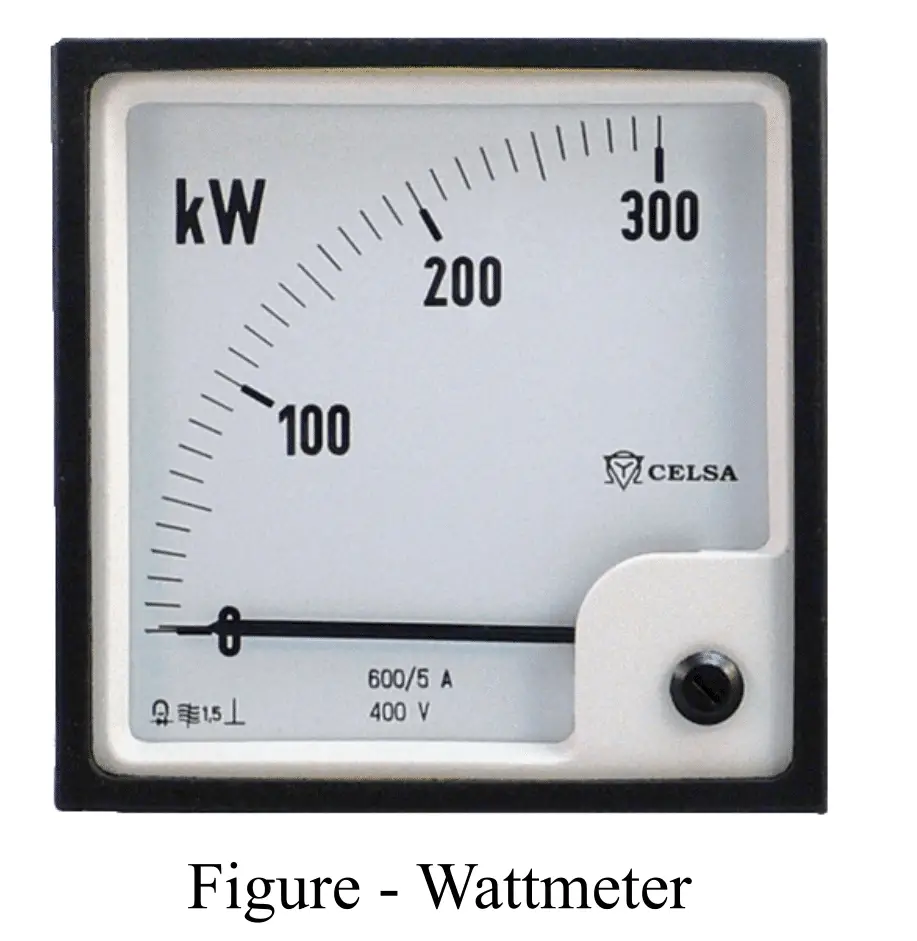Wattmeter and energy meter are the two widely used measuring devices in electrical circuits and systems. The key difference between a wattmeter and an energy meter is that the wattmeter is used to measure electrical power consumed in the electrical system, whereas the energy meter is used to measure electrical energy expanded in the electrical system over a certain period of time.
Before discussing the differences between a wattmeter and an energy meter, let us first discuss a bit about them individually.
What is a Wattmeter?
A wattmeter is an electrical measuring instrument used to measure the power consumed in an electrical circuit. Wattmeter measures active power in watts, kilowatts, etc. The working of a wattmeter is based on the principle of electromagnetic law which states that whenever a current-carrying conductor is placed in a magnetic field, an electromagnetic force acts on it.

A wattmeter typically consists of two coils/windings namely the current coil (CC) and potential coil (PC). The current coil is put in series with the electrical load, while the potential coil is connected in parallel with the load. Therefore, the current coil carries the full load current, and the potential coil carries the full load voltage.
Whenever an electric current flows through the load and hence through the current coil of the wattmeter, due to electromagnetic effect the moving coil rotates. The pointer attached to the moving coil of the wattmeter deflects on the calibrated scale to show the power reading in terms of watts or kW.
Wattmeters are widely used in electrical circuits and power systems to measure electrical power consumed.
What is an Energy Meter?
An energy meter is also an electrical measuring device used to measure electricity/electrical energy consumed over a period of time in an electrical circuit. Energy meters measure electricity consumed in several units such as joules, watt-hour, kWh, etc.

In electrical industries, the most commonly used unit of energy measurement is the kilo-watt-hour (kWh). The working of an energy meter is based on the principle of conversion of electrical energy into mechanical energy, i.e. electromechanical energy conversion principle.
Whenever electricity flows through the energy meter coils, the aluminum disc of the meter revolves. A counter mechanism is used to count the revolutions made by the aluminum disc in a certain period of time. The reading on the counter screen displays the energy consumed in the circuit. The speed of the disc depends on the current flowing through the circuit and hence on the power consumed in a particular time period.
Energy meters are the most commonly used device in industries and homes to measure electrical energy consumption and for billing purposes.
Hence, this is all about the basics of a wattmeter and energy meter. Now, let us discuss the differences between a wattmeter and an energy meter.
Difference between Wattmeter and Energy Meter
The key differences between a wattmeter and an energy meter are listed in the table below.
| Characteristic | Wattmeter | Energy Meter |
| Definition | An electronic measuring instrument used to measure electrical power consumed in a circuit is called a wattmeter. | An electronic instrument used to measure electrical energy consumed in an electrical circuit is called an energy meter. |
| Quantity measured | Wattmeter measures electrical power. | An energy meter measures electrical energy. |
| Units of measurement | Wattmeter displays readings in watts, kilowatts, etc. | The energy meter displays readings in joules, watt-hour, kilowatt hour, etc. |
| Components | A wattmeter consists of a current coil, a potential/pressure coil, a control mechanism, a damping system, a pointer, and calibrated scale. | An energy meter consists of a driving system, aluminum disc, counter mechanism, and braking system. |
| Principle of operation | Wattmeter works on the principle of electromagnetic induction, i.e. a current-carrying conductor placed in a magnetic field experiences a force. | An energy meter works on the electromechanical energy conversion principle, i.e. electrical energy is converted into mechanical energy. |
| Types | There are three types of wattmeters namely, electrodynamometer wattmeter, induction wattmeter, and electrostatic wattmeter. | There are two types of energy meters namely, electromechanical energy meters and electronic energy meters. |
| Instrument Category | Wattmeter is an indicating type measuring instrument. | An energy meter is an integrating type of measuring instrument. |
| Application | Wattmeters are used to measure electrical power consumed, determine power ratings of devices, perform experiments in labs, etc. | Energy meters are used to measure the amount of electricity consumed by a load in a certain period of time. |
Conclusion
In conclusion, we highlighted the significant differences between the wattmeter and the energy meter in the above table. The most significant difference between a wattmeter and an energy meter is that a wattmeter is used to measure electrical power in watts, while an energy meter is used to measure electrical energy consumed by the electrical load in a watt-hour.